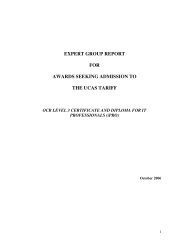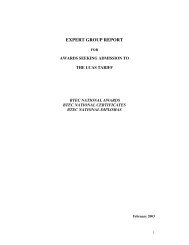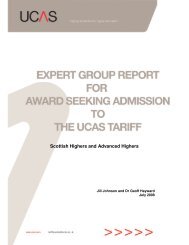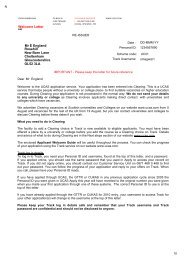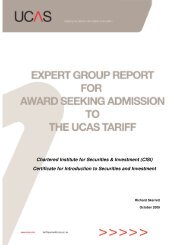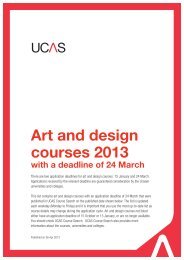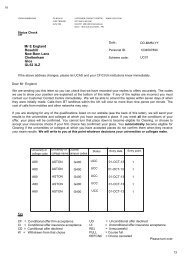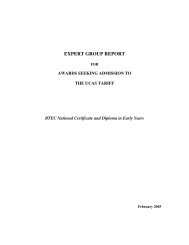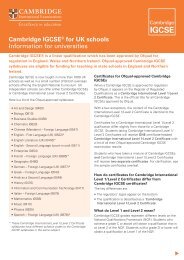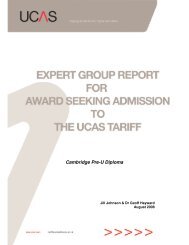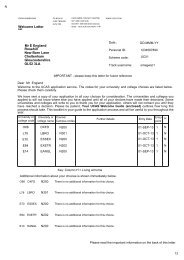International qualifications 2013 (pdf) - CUKAS
International qualifications 2013 (pdf) - CUKAS
International qualifications 2013 (pdf) - CUKAS
Create successful ePaper yourself
Turn your PDF publications into a flip-book with our unique Google optimized e-Paper software.
Qualifications currently offered<br />
Uzbekistan<br />
EVALUATION<br />
Attestat o srednem obrazovanii (Certificate of Secondary<br />
Education)<br />
Acceptable in lieu of GCSE on a subject for subject basis (except<br />
English language).<br />
O’rta Ma’lumot To’g’risida Shahodatnoma<br />
Acceptable in lieu of GCSE on a subject for subject basis (except<br />
English language).<br />
GRADING SYSTEM<br />
100 – 86% Excellent<br />
85 – 71 Good<br />
70 – 56 Satisfactory<br />
55 or less Unsatisfactory<br />
EDUCATION SYSTEM<br />
Four years of primary education is followed by five years of lower<br />
secondary and a further three years in an academic lyceum or a<br />
professional college. Uzbek is the medium of instruction in the<br />
majority of schools, although Russian is still widely used. English has<br />
replaced Russian as the foreign language of choice for most<br />
students. There is a wide range of HE institutions in Uzbekistan,<br />
although those located outside the capital are generally more poorly<br />
resourced.<br />
ACCESS TO HIGHER EDUCATION<br />
On completion of their secondary education (academic lyceum or<br />
professional college), students sit a nationally administered<br />
multiple-choice examination for entry into HE. Application can be<br />
made to only one university in a given year. A pass mark is set by<br />
each university and students achieving this are eligible for<br />
government scholarships. Increasing numbers of fee-paying or<br />
‘contract’ students are also being accepted.<br />
Venezuela<br />
EVALUATION<br />
Bachillerato<br />
Título de Bachiller<br />
Comparable to GCSE standard (grades A, B, C) on a subject for<br />
subject basis (except English language).<br />
Técnico Medio<br />
Comparable to BTEC First Diploma standard.<br />
Técnico Superior<br />
Considered comparable to BTEC National Diploma standard.<br />
GRADING SYSTEM<br />
The grading is on a scale of 20–1, with 10 as the minimum<br />
pass mark.<br />
The academic year is divided into three or more periods. Grades<br />
are given for each period. At the end of the year, the grades are<br />
averaged to form a previa grade.<br />
EDUCATION SYSTEM<br />
There are nine years of basic compulsory education combining<br />
primary and secondary from the age of six to 14. At secondary<br />
level (age 14 to 16), students can choose diversified secondary and<br />
train for the Bachillerato in science, arts and/or humanities; or they<br />
can train for the Técnico Medio at an Educacion Media Profesional.<br />
Studies are divided into industrial husbandry, commercial and<br />
health sectors. The medium of instruction is Spanish.<br />
ACCESS TO HIGHER EDUCATION<br />
Admission to university level and non-university level studies<br />
(technical/vocational type) requires students to have obtained the<br />
Bachillerato with the minimum mark of 10, and sit the Prueba de<br />
Apitúd Académica aptitude test. Some universities have their own<br />
admission test in order to select the best prepared students.<br />
A recent change for higher education access is registration on to<br />
the national system of higher education (Registro Unico para el<br />
Sistema de Educación Superior - RUSNIES).<br />
Vietnam<br />
EVALUATION<br />
Lower Secondary School<br />
Generally considered to be below the standard of GCSE.<br />
Tot Nghiep Pho Thong Trung Hoc (Upper Secondary School<br />
Graduation Certificate)<br />
Considered to be between GCSE and A level standard.<br />
GRADING SYSTEM<br />
10 – 9.0 Excellent<br />
8.0 – 7.0 Good<br />
6.5 – 5.0 Pass<br />
4.5 and below Fail<br />
EDUCATION SYSTEM<br />
The system comprises 12 grades of which the first nine are, in<br />
principle, compulsory. The language of instruction is Vietnamese,<br />
although some ethnic minority students receive pre-school and<br />
primary instruction in their own language while learning<br />
Vietnamese.<br />
Upper school – on completion of a nine-year basic education,<br />
pupils can either continue their studies at upper secondary school<br />
or move to vocational training. Upper secondary education lasts<br />
three years, covering grades 10, 11 and 12. Upper secondary<br />
schools admit those who have completed basic education and<br />
prepare pupils for further education. The syllabus at upper<br />
secondary schools is a continuation of that at the basic education<br />
schools. Examinations are taken at the end of each term.<br />
On successful completion of upper secondary school education,<br />
pupils are awarded the Bang Tot Nghiep Pho Thong Trung Hoc<br />
(Upper Secondary School Graduation Certificate).<br />
Vocational training is provided at three levels: vocational<br />
elementary, vocational secondary and vocational diploma.<br />
Courses are delivered by vocational training centres, vocational<br />
secondary schools and vocational colleges.<br />
Elementary level courses last one month, three months or six<br />
months, depending on the demand of employers. Vocational<br />
secondary level courses admit graduates of upper secondary<br />
schools or lower secondary schools for one-and-a-half to two<br />
years or three years respectively. Vocational diploma courses<br />
admit graduates of upper secondary schools or vocational<br />
secondary schools for two-and-a-half to three years, or one to<br />
one-and-a-half years respectively.<br />
The vocational system ensures good articulation between the<br />
three levels and between the vocational and academic routes,<br />
eg learners from lower secondary schools can take a three-year<br />
course at vocational secondary schools to get certificates in<br />
certain trades and upon graduation, they can sit the national<br />
examination to enter universities.<br />
64 INTERNATIONAL QUALIFICATIONS



